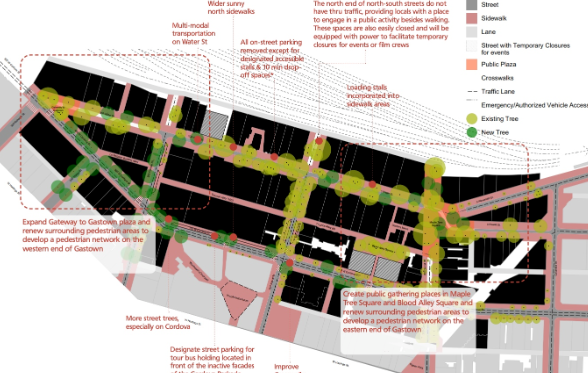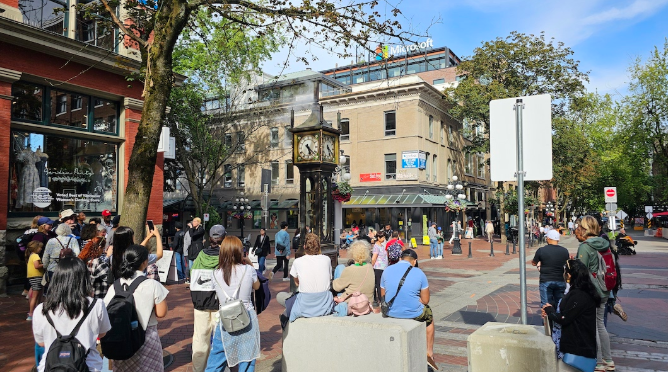The City of Vancouver has laid out a bold vision for one of its most iconic neighbourhoods. The Gastown Public Spaces Plan, a multi-year initiative aimed at revitalizing public areas in the historic district, is shaping up to be one of the city’s most transformative urban projects. With a blend of heritage preservation, reconciliation, accessibility improvements, and modern placemaking, this initiative is designed to make Gastown more vibrant, inclusive, and people-focused.
A Neighbourhood at a Crossroads
Gastown is a National Historic Site and one of Vancouver’s most visited destinations. Yet beneath the charm of cobblestone streets and heritage facades lies aging infrastructure and a community grappling with complex urban challenges.
Situated on the unceded territories of the Musqueam, Squamish, and Tsleil-Waututh Nations, Gastown is not only a centre for arts, fashion, and tech startups but also part of the Downtown Eastside, home to some of Vancouver’s most vulnerable populations. The plan acknowledges these realities while proposing a vision that centres on community, equity, and Indigenous visibility.
Reimagining Public Life on Water Street
At the heart of the proposal is the pedestrianization of Water Street, a symbolic and literal artery through Gastown. Informed by the success of past pilots, the city will launch a pedestrian-only zone during summer weekends and special events starting in 2025, building on a summer 2024 pilot.
Water Street’s transformation is about more than just closing roads. It’s about creating space for community gathering, sidewalk patios, public art, and Indigenous storytelling. Opportunities identified through community engagement include improved accessibility for mobility devices, enhanced safety, and activation through events and programming. Still, concerns about cleanliness, encampments, and the impact on local businesses—especially around delivery access and parking—remain top of mind.

*Photo by City of Vancouver
Enhancing Streets, Laneways, and Squares
Beyond Water Street, the plan targets improvements across Cordova Street, Maple Tree Square, and the neighbourhood’s laneways. In 2025, a two-way traffic pilot on Cordova between Richards and Gore will assess potential network changes.
Repairs to cracked sidewalks, mismatched patching, and deteriorating pavers—especially along Water Street and Maple Tree Square—are also urgently needed. The city plans to replace original brickwork and address tripping hazards, making Gastown more walkable and accessible for all.
Advancing Reconciliation and Cultural Recognition
A critical component of the plan is advancing Reconciliation. Gastown currently lacks visible representation of the Musqueam, Squamish, and Tsleil-Waututh peoples. In response, the city is partnering with the local Nations to incorporate Indigenous histories, languages, and artwork into the streetscape.
A prominent early example is the development of a culturally inspired information kiosk at the former site of the Gassy Jack statue, in collaboration with the Squamish Nation. Future design elements will aim to reflect Indigenous presence through naming, public space design, and cultural programming.
Investment and Funding Challenges
The transformation of Gastown is a multi-phase project, both in design and funding. The 2023–2026 Capital Plan has allocated $10 million, up from an initial $7 million, to support urgent repairs and planning. However, the total cost is expected to reach $35 million, leaving a substantial funding gap.
The city is exploring ways to secure the next phases of funding through the 2024 Capital Plan Mid-term Update and future budget cycles. About $13 million is needed for Phase 2 construction, with an additional $15 million projected for the final phase between 2027 and 2030.
Listening to the Community
The city’s phased engagement approach has so far included over 3,500 community touchpoints, spanning surveys, pop-ups, workshops, and one-on-one meetings with local businesses. Feedback from Phase 1 (Fall 2023 to Winter 2024) revealed both optimism and caution.
Community members voiced strong support for enhanced public spaces and pedestrianization, but also highlighted concerns around safety, sanitation, and the need for basic amenities like washrooms, seating, and drinking fountains. Many emphasized the importance of preserving Gastown’s heritage while making space for underrepresented voices, especially Indigenous communities.
The next engagement phases, scheduled through 2025 and into 2026, will further shape the plan’s priorities and finalize the design for Council review.
A Vision Rooted in Place
The Gastown Public Spaces Plan is about more than restoring bricks and redesigning streets. It’s a forward-looking effort to balance heritage and inclusivity, commerce and culture, safety and liveliness.
If successful, it could serve as a model for how historic urban centres can evolve with integrity—embracing the past, responding to present-day needs, and creating space for future generations.
Curious how Gastown’s transformation might impact the local real estate scene—or what this could mean for heritage preservation in downtown Vancouver? We’re watching this closely. Want to stay ahead of the curve? Let’s connect.
